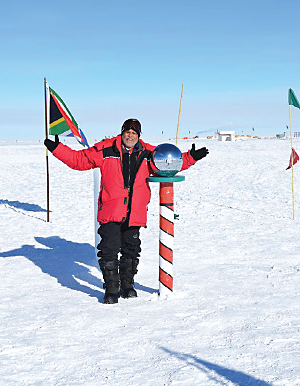Jagannathan Srinivasaraghavan, M.D., set a personal record when he landed in Libya on February 29. With that country’s bloody civil war over, Dr. Van, as he is generally known, visited the last of the 195 officially designated nations on the planet.
“I believe I am the world’s most traveled psychiatrist,” said the professor emeritus of psychiatry at Southern Illinois University School of Medicine.
He also ranks 33rd on a list by the Web site
http://mosttravelledpeople.com/, which subdivides the world a bit differently and lists 872 geographic entities (including states and provinces). Van has logged visits to 580 sites on that list.
In Libya, Van saw the bombed-out compound of the late dictator Mu’ammar Gadhafi. Then he visited some much older ruins, the ancient cities of Cyrene and Leptis Magna.
“Leptis was beautiful, a classic Roman city with a great arch at its center,” he said.
Getting there brought reminders of up-to-date-reality, though. Traveling outside major cities in Libya required passing through multiple checkpoints, where roadblocks were controlled by young men with AK-47s, he said.
He is no stranger to conflict zones. In 2011, he visited Afghanistan and Iran. Earlier this year, on his way to Libya, he visited South Sudan, a nation created only a year ago but now also embroiled in difficulties with its former parent, Sudan.
Van has been traveling for more than 40 years. When he first arrived in the United States from India in 1977, it was only his seventh country, but he circled the world by 1979, and with a few leaves of absence in the 1980s, reached 100 countries by the early 1990s. He made it to both Antarctica and the North Pole in 1985 and says he was the first Indian citizen to plant the Indian flag on the top of the world.
By 2006, he had logged 140 countries and, after retiring in 2008, pushed the count up to 168.
In December 2011, he went to the South Pole to mark the 100th anniversary of Roald Amundsen’s trek.
Van occasionally plays the visiting fireman, dropping in on the local psychiatrists, like the lone practitioner on the island nation of Kiribati in the South Pacific.
He noted that many countries allocate few resources to health in general and even less to mental health.
“We come from an elite mentality about psychiatric care, but that is wrong,” he said. “Many psychiatrists around the world are doing the best they can with the minimal resources they have.”
Van likes different places for different reasons. One country might have beautiful scenery, another may be home to an old civilization, while a third simply has people with whom he enjoys talking.
“I love islands where the mountains and the sea are close together,” he said. That includes place like Bora Bora or Fiji in the South Pacific, Lord Howe Island off the coast of Australia, or Reunion Island in the Indian Ocean.
He politely demurs on naming the worst place he’s visited, except to say he was afraid to go out at night there.
Next on his list was to be the territory of Nakhichevan, an enclave of Azerbaijan entirely surrounded by Armenia and the subject of a brief armed conflict between the two countries in 1992. However, his request for a visa was denied, delaying that trip indefinitely.
What lessons can this traveler to antique and modern lands offer to those dreaming to take off on their own voyages?
“The more you travel and meet people, the more you find they’re the same,” he said. “They all want happiness. They all want things better for their kids. Also, the poorer the place, the more heart the people have, and the more they share with you the little they have.”



